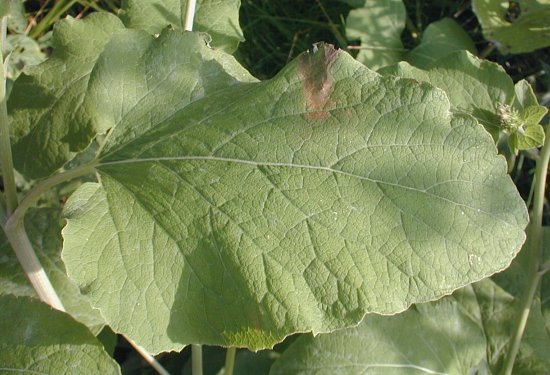Description: This herbaceous biennial plant is a low-growing rosette of basal leaves during the first year, but during the second year it becomes 3-6' tall. The second-year plant is little branched below, but produces short flowering side stems above. The stems are rather stout, round or slightly ridged in circumference, and light green to slightly reddish green. Young stems are covered with white cobwebby hairs, but older stems become glabrous and have conspicuous longitudinal veins. The basal leaves are up to 2' long and 1½' across. They have long petioles and resemble the leaves of rhubarb to some extent. The lower leaves of second year plants resemble the basal leaves, except that they are somewhat smaller. These leaves are ovate-cordate, dull green above, and whitish green below, with blunt tips. They are nearly glabrous above, but finely pubescent below. Their margins are somewhat undulate, crisped, or smooth, sometimes with a few blunt teeth. Their long petioles have a conspicuous furrow above and they are usually hollow inside. The middle to upper leaves of second year plants are similar in appearance, but they are smaller in size and more likely to be ovate with margins that are more smooth and petioles that are shorter.

The upper stems
terminate in small clusters of flowerheads on short stalks. Each
flowerhead is about ¾–1" across, consisting of numerous disk florets
and floral bracts that have narrow hooked tips. There are no ray
florets. Each disk floret has a corolla that is narrowly cylindrical
with 5 slender upright lobes at the apex. The disk florets are usually
some shade of pink or purple, although a rare form of Common Burdock
with white florets occurs. The slender white style is strongly exerted
from the corolla and bifurcated at its tip. The dark purple anthers
form a sheath around the style that lies just above the lobes of the
corolla. The abundant bracts are green at the base, but become
yellowish green toward the their hooked tips. They have a spiny
appearance and have few, if any, cobwebby hairs in their midst. The
blooming period occurs from mid-summer to early fall, and lasts about a
month for a colony of plants. The achenes are oblong, broader and more
truncate at one end than the other, and light brown with dark brown
speckles. At the apex, each achene has a crown of fine bristles, but
these are deciduous and soon fall off. The floral bracts turn brown and
enclose the withered flowers at the top, forming a bur. The burs are
persistent and remain on the stalks after the leaves have withered away
during the fall. The root system consists of a stout taproot that runs
deep into the ground. This plant spreads by reseeding itself, and often
forms colonies of variable size.
Cultivation:
Common Burdock is often found in full or partial sun, slightly moist to
mesic conditions, and a loamy fertile soil. It has a robust nature and
can be found in other kinds of soil and drier conditions. It is often
aggressive.

Range &
Habitat:
This non-native plant is common in central and northern Illinois, but
less common
or absent in southern Illinois (see Distribution
Map). This is by far the most common Arctium sp.
(Burdock) in the state. It is adventive from Northern Europe and also
occurs in Asia. Habitats include woodland edges, savannas, thickets,
pastures, edges of fields and fence rows, weedy meadows, barnyards,
areas along roads and railroads, and waste areas. Disturbed areas are
preferred, although it occasionally appears in more pristine natural
areas, particularly along paths and animal trails.
Faunal Associations:
The flowers are pollinated primarily by long-tongued bees, including
bumblebees, honeybees, Miner bees, and Leaf-Cutting bees, which suck
nectar and collect pollen. Other visitors include bee flies,
butterflies, and skippers, which seek nectar and are also effective at
pollination. The caterpillars of several Papaipema spp.
(Borer Moths) bore through the pith of the stems, including Papaipema
cataphracta (Burdock Borer Moth), Papaipema
arctivorens (Northern Burdock Borer Moth), and Papaipema
rigida (Rigid Sunflower Borer Moth). The foliage of Common
Burdock is one of the food sources for the caterpillars of the
butterfly Vanessa cardui (Painted Lady). The
Ring-Necked Pheasant eats the seeds to a limited extent. Because the
foliage is bitter-tasting, Common Burdock is not a preferred food plant
for mammalian herbivores, although livestock and deer will browse on it
if nothing else is available. There is some evidence that the foliage
may be toxic to rabbits. The seeds are distributed far and wide by
animals and humans because the burs cling readily to fur and clothing.
They are quite difficult to remove.

Photographic
Location:
Along a fence row at the webmaster's apartment complex in Urbana,
Illinois.
Comments:
Apparently, the stout taproot has a sweet taste and can be used as
food. Similarly, if the outer husk of the stems are peeled away, the
pith can be used like a vegetable. There are 3 Arctium spp.
(Burdocks) in Illinois. One of them, Arctium tomentosum
(Woolly Burdock) has abundant cobwebby hairs that cover the floral
bracts below their hooked tips. Another species, Arctium lappa
(Great Burdock), is often taller than Common Burdock, and it has larger
flowerheads about 1–1½" across. The flowerheads of Great Burdock have
longer stalks and they are arranged in flat-headed cymes, whereas the
flowerheads of Common Burdock are more vertically bunched together on
short stalks, as revealed in the upper photograph. The petioles of the
lower leaves in Great Burdock are less furrowed on the upper surface
and they are solid inside, rather than hollow.